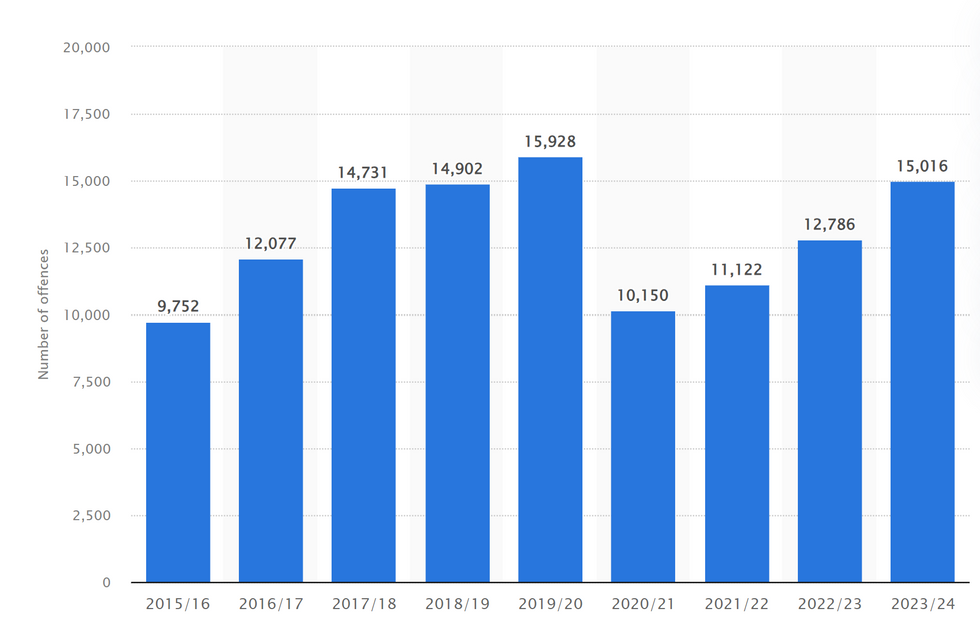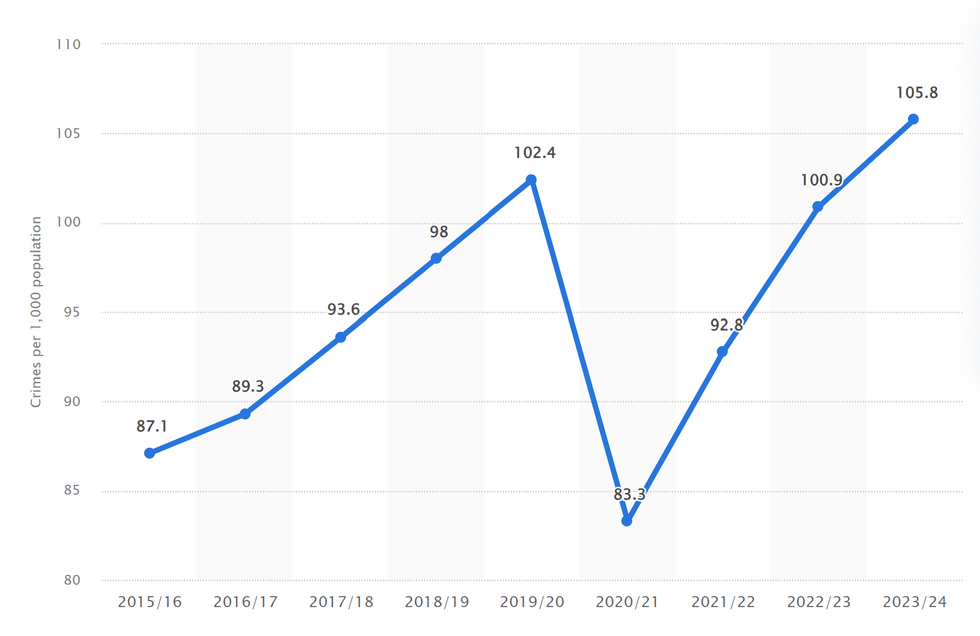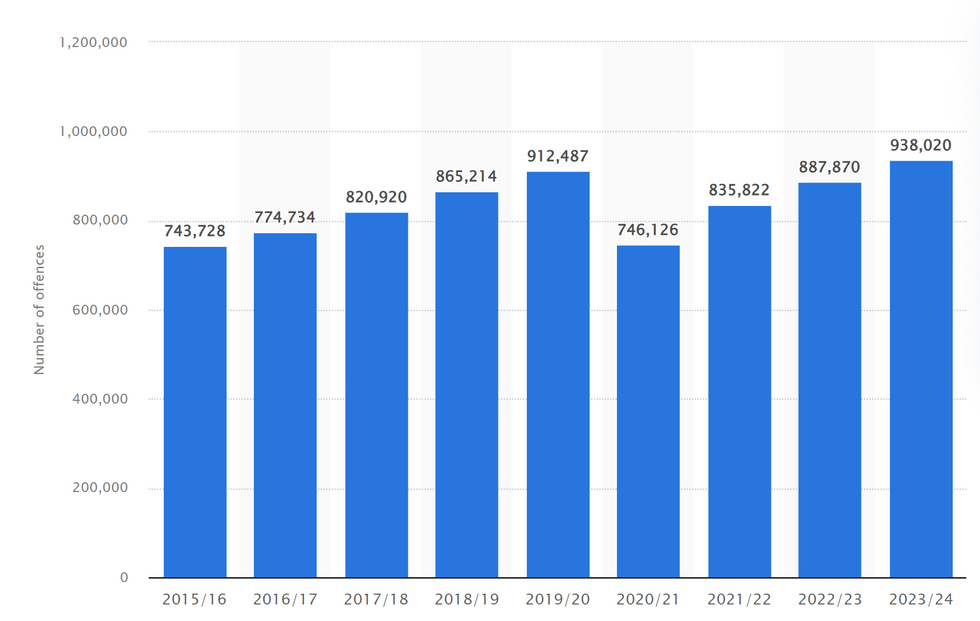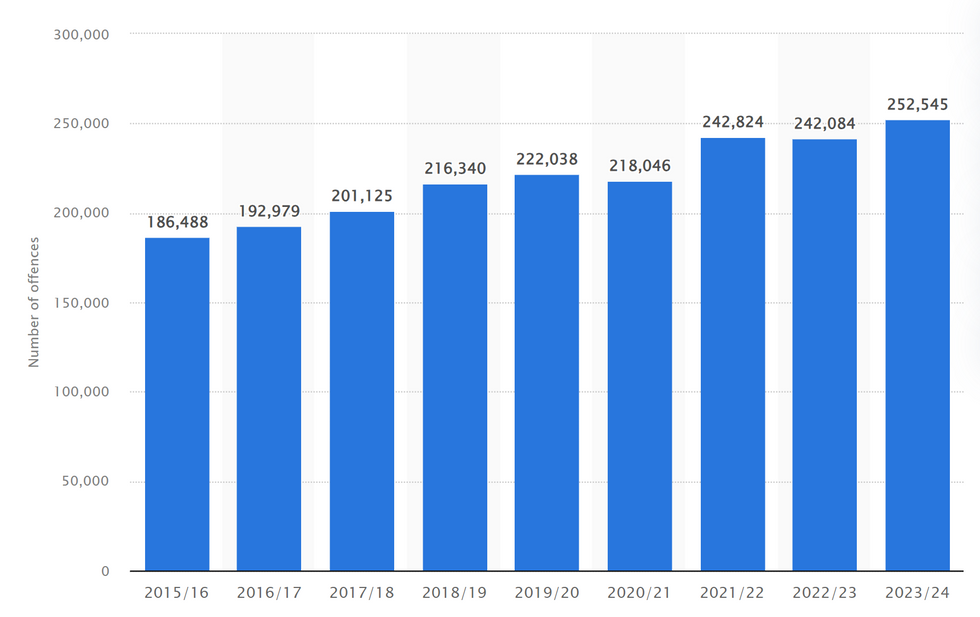Sadiq Khan became the mayor of London on 9 May 2016
Getty/ © Statista 2024
Crime rates, including violent offences and knife offences, have increased in London since the previous year
Don't Miss
Most Read
Trending on GB News
On Monday, an 11-year-old girl was taken to hospital after being stabbed repeatedly by a man at Leicester Square, London.
The police were called to the busy square at 11:34 am following reports the girl and a 34-year-old were attacked.
The knife attack, which happened in broad daylight in the middle of a busy, tourist hot spot, is a reminder of the fears that Londoners have about the safety of their streets.
Sadiq Khan, who became the mayor of London in May 2016, also acts as police and crime commissioner for the city and is responsible for the totality of policing in the capital.
Number of police recorded knife or sharp instrument offences in London from 2015/16 to 2023/24

This graph shows the number of knife crime offences has rose to approximately 15,016 in 2023/24 compared with 12,786 the previous year
© Statista 2024
Knife Crime
New figures show the number of knife or sharp instrument offences recorded by the police in London rose to approximately 15,016 in 2023/24 compared with 12,786 the previous year.
This was the highest number of knife crime offences reported in London since 2019/20 where there were 15,928 offences.
Between 2015/16 and 2019/20 knife crime offences reported in London increased yearly before a drop in offences in 2020/21 to 10,150 during the Covid pandemic before increasing yearly again.
The increase in knife crime witnessed in London has occurred alongside a general increase in offences involving knives or sharp instruments in England and Wales, according to the Office for National Statistics.
According to the Crime in England and Wales 2024 report, knife-enabled crime recorded by the police in 203/24 increased by 4 per cent (50,510) compared with the previous year (48,409).
There has also been a notable increase in the number of robberies involving a knife (up 13 per cent compared to the previous year).
Knife-enabled crime continued to be concentrated in metropolitan areas across England and Wales last year, with 30 per cent of all offences recorded by the Metropolitan Police Service and 10 per cent by the West Midlands Police.
Crime rate per 1,000 population in London from 2015/16 to 2023/24

This graph shows the crime rate in London was 105.8 crime offences per thousand people for 2023/24
© Statista 2024
Crime rate per 1,000 population
The crime rate in London was 105.8 crime offences per thousand people for 2023/24, compared with 100.9 in the previous year.
Similar to knife crime, between 2015/16 and 2019/20 crime rates per 1,0000 population increased each year with a sudden drop in 2019/20 due to the Covid pandemic which has gradually increased each year to higher than pre-pandemic records.
A rise in crime in London happened alongside a decline in both personnel and funding from the London Metropolitan Police.
In 2018, there were around 3,000 fewer police officers than compared to 2010 while annual funding was reduced by some 3.3 billion between 2013/14 and 2018/19.
There have recently been pledges to increase spending and recruit more police and in 2023/24 the budget for the Metropolitan Police was 4.53 billion pounds, while the number of officers in 2022 increased to 33,984.
Number of police recorded crime offences recorded in London from 2015/16 to 2023/24

This graph shows there were 938,020 crimes recorded in London in the 2023/24 reporting year
© Statista 2024
Number of police recorded crime offences
There were 938,020 crimes recorded in London in the 2023/24 reporting year, compared with 887,870 in the previous year which exceeds the previous peak figure of 912,487 in 2019/20.
When Khan came into power in 2016/17, the number stood at 774,734 compared to 938,020 this year, marking a 21 per cent increase.
Compared to pre-pandemic levels, some types of crime have yet to reach the same levels as they were in 2019/20 with the number of criminal offences relating to theft and drugs slightly down in 2023/24.
On the other hand, the number of violent crimes peaked at 252,545 offences in 2023/23, while the number of sexual offences in the capital since 2021/22 is far higher than in previous years.
The increase in crime is part of a wider trend afflicting the rest of the country with the overall crime rate for England and Wales in 2023/24 at 89.7 crimes per 1,000 people.
This was slightly lower than in 2022/23 where the crime rate was at its highest since 2006/07.
Furthermore, the Metropolitan Police responsible for policing Greater London, had the sixth-highest crime rate among police forces with Cleveland police force in North East England having the highest.
Number of police recorded violence against the person offences in London from 2015/16 to 2023/24

There were 252,545 violent crime offences recorded in London in 2023/24
© Statista 2024
Police recorded violent crimes
There were 252,545 violent crime offences recorded by the Metropolitan Police and City of London Police Forces in London in 2023/24, an increase from 242,084 the previous year.
In 2016/17 there were 192,979 recorded violent crimes compared to 252,545 in the latest statistics which is a 30 per cent increase.
This reflects a pattern of increasing violent crime across England and Wales as a whole, with a peak of 2.1 million offences reported in 2022/23.
The latest figures from the Office for National Statistics show that the violent crime rate is lower in London than in the rest of England and Wales.
In the twelve months to December 2023, there were 28.4 violence against the person offences per 1,000 population in the Met area, lower than the average for the rest of England and Wales of 35.0per 1,000 populationand lower still than the average for the Met’s group of most similar sized police force areas – such as Greater Manchester, West Yorkshire and the West Midlands (48.7).
A spokesperson for the Mayor of London said: “Nothing is more important to the Mayor than keeping Londoners safe and he continues to invest record amounts in the police and initiatives to support young Londoners.
“The latest ONS figures show there has been an increase in recorded knife crime across England and Wales – this is a nationwide issue.
"The stats also show the violent crime rate is lower in London than in the rest of England and Wales however there is clearly work to do which is why the Mayor is focused on prevention, with his Violence Reduction Unit investing more in youth clubs and creating 350,000 interventions and positive opportunities for young people. This is in addition to a new £2 million investment in a package of activities, training and targeted interventions this summer to divert thousands of young people away from violence.”
LATEST FROM MEMBERSHIP:
- 'Can I claim Carer's Allowance if I get the state pension and have a small private pension?'
- 'A hidden epidemic is affecting our children this summer...and I know what's causing it'
- Politicians are framing protests and riots to serve their political agenda - the Left does this to perfection - Sally-Ann Hart
Speaking on GB News, former Home Office minister Chris Philp MP said police chiefs need to introduce surge policing hot spots to tackle knife crime in the capital.
Philp said: "There's a few things I would expect the Government to be doing…a ban will come into force in September to outlaw some zombie knives and machetes that should have been that should be outlawed, that's going to come into force in a few weeks’ time.
"I would like to see hot spot patrols, surge policing going into those areas where there are problems. The previous government, the Conservative government put in funding, about £70 million of extra money this year to fund those hot spot patrols.
"I want to see those police out on the street, hot spot patrolling. And of course, Leicester Square, where this incident occurred today, is exactly the kind of area where you would expect the extra hot spot patrols to take place, as well as places like Croydon town centre, the borough that I represent in Parliament."
Philip also spoke about stop and search being important although a number of Labour politicians including Sadiq Khan are very "squeamish" about using it.
He continued: "The truth is, stop and search, when it was being used more widely, was taking almost 500 knives a month off London's streets. Stopping people, searching them and taking a knife off them I think is an effective way of protecting the public.
"I remember there was a case in Croydon last year where a young girl was stabbed one morning. But if only that perpetrator had been stopped and searched, then maybe she would still be alive today.
"The other thing I'd like to see deployed is technology to scan people at a distance to see if they're carrying knives."







